Abstract
BACKGROUND--Nocturnal airway narrowing is a common problem for patients with asthma but the role of inflammation in its pathogenesis is unclear. Overnight changes in airway inflammatory cell populations were studied in patients with nocturnal asthma and in control normal subjects. METHODS--Bronchoscopies were performed at 0400 hours and 1600 hours in eight healthy subjects and in 10 patients with nocturnal asthma (> 15% overnight fall in peak flow plus at least one awakening/week with asthma). The two bronchoscopies were separated by at least five days, and both the order of bronchoscopies and site of bronchoalveolar lavage (middle lobe or lingula with contralateral lower lobe bronchial biopsy) were randomised. RESULTS--In the normal subjects there was no difference in cell numbers and differential cell counts in bronchoalveolar lavage fluid between 0400 and 1600 hours, but in the nocturnal asthmatic subjects both eosinophil counts (median 0.11 x 10(5) cells/ml at 0400 hours, 0.05 x 10(5) cells/ml at 1600 hours) and lymphocyte numbers (0.06 x 10(5) cells/ml at 0400 hours, 0.03 x 10(5) cells/ml at 1600 hours) increased at 0400 hours, along with an increase in eosinophil cationic protein levels in bronchoalveolar lavage fluid (3.0 micrograms/ml at 0400 hours, 2.0 micrograms/l at 1600 hours). There were no changes in cell populations in the bronchial biopsies or in alveolar macrophage production of hydrogen peroxide, GM-CSF, or TNF alpha in either normal or asthmatic subjects at 0400 and 1600 hours. There was no correlation between changes in overnight airway function and changes in cell populations in the bronchoalveolar lavage fluid. CONCLUSIONS--This study confirms that there are increases in inflammatory cell populations in the airway fluid at night in asthmatic but not in normal subjects. The results have also shown a nocturnal increase in eosinophil cationic protein levels in bronchoalveolar lavage fluid, but these findings do not prove that these inflammatory changes cause nocturnal airway narrowing.
Full text
PDF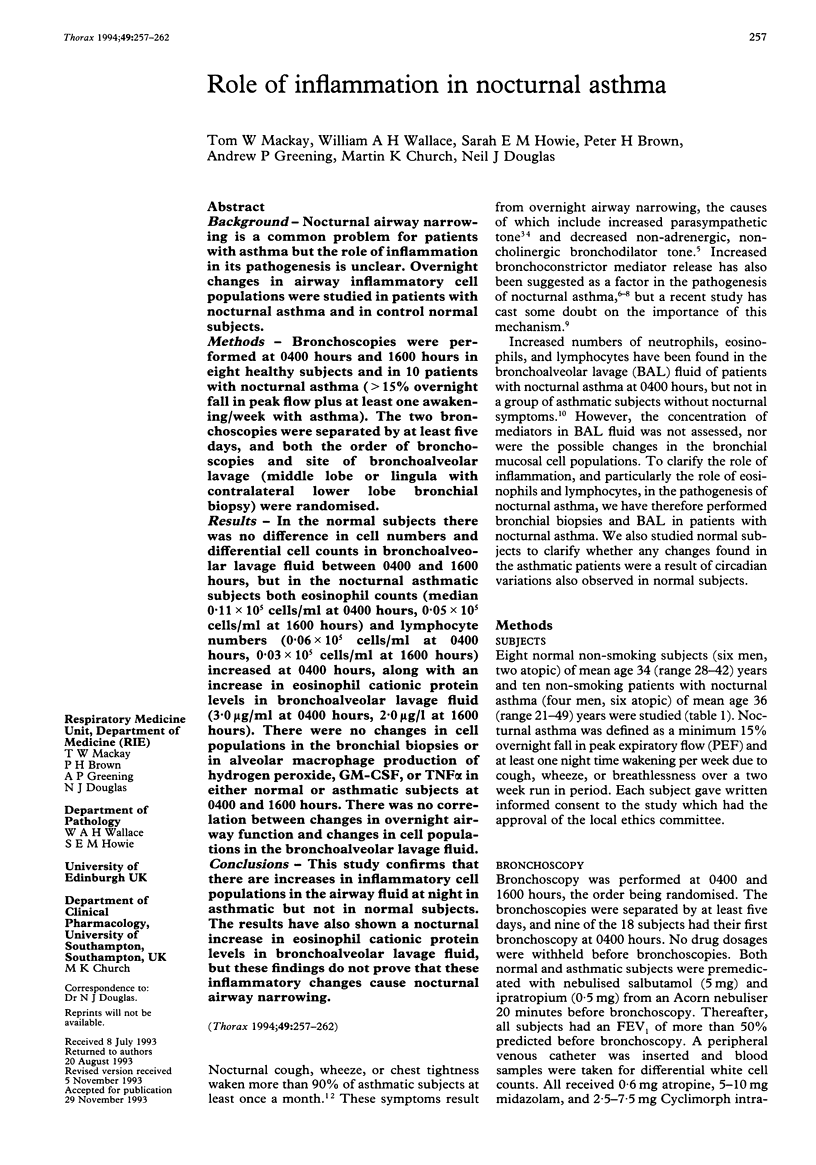
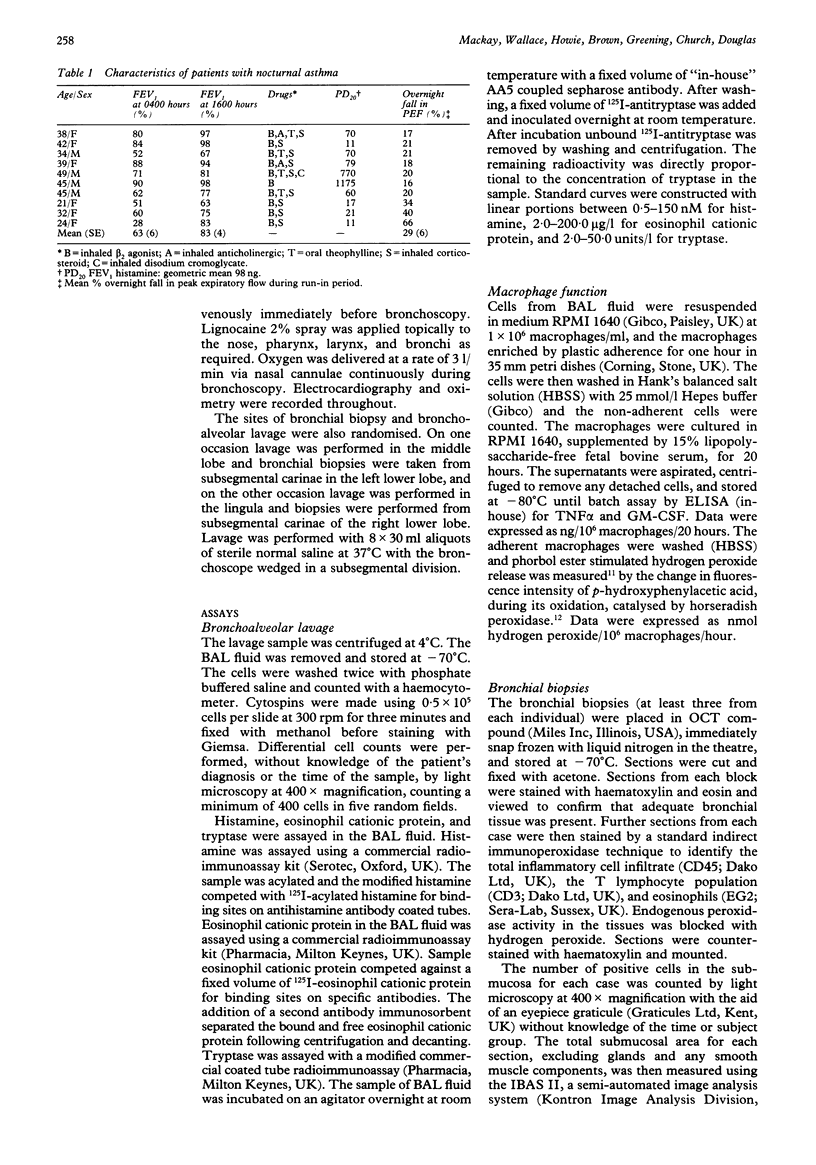
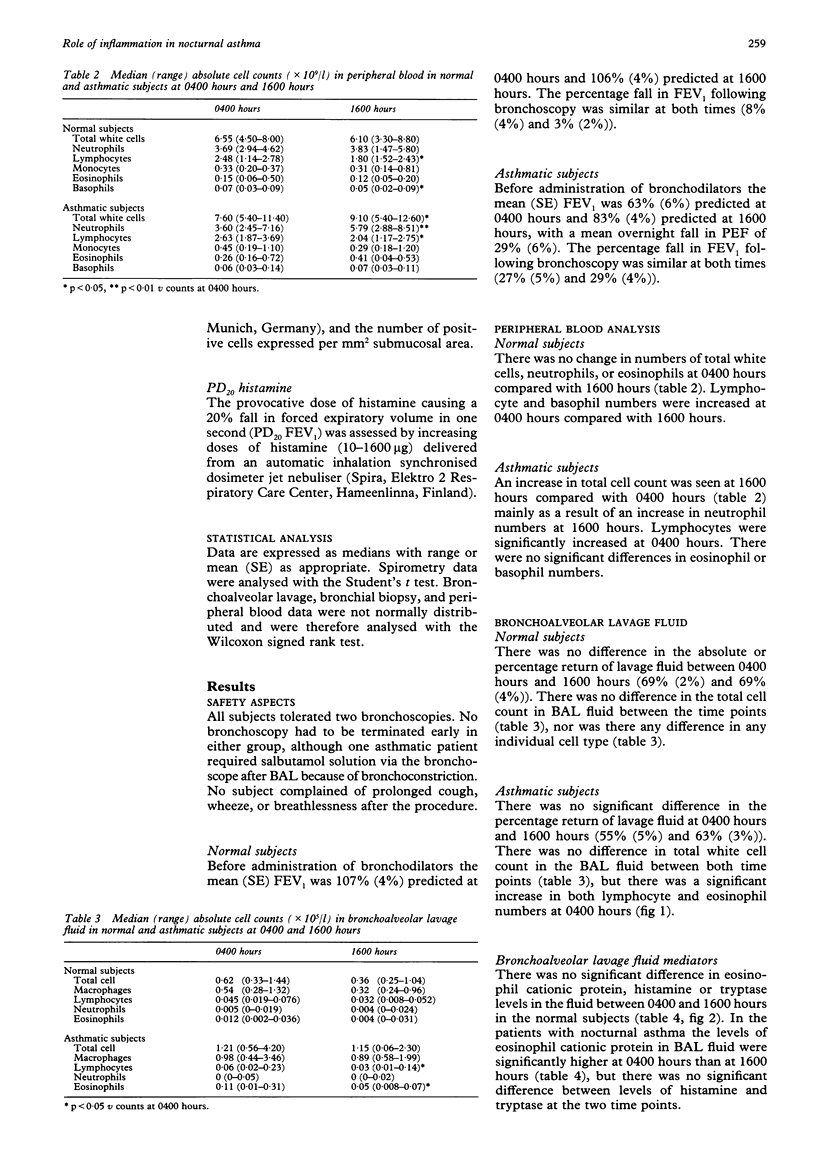
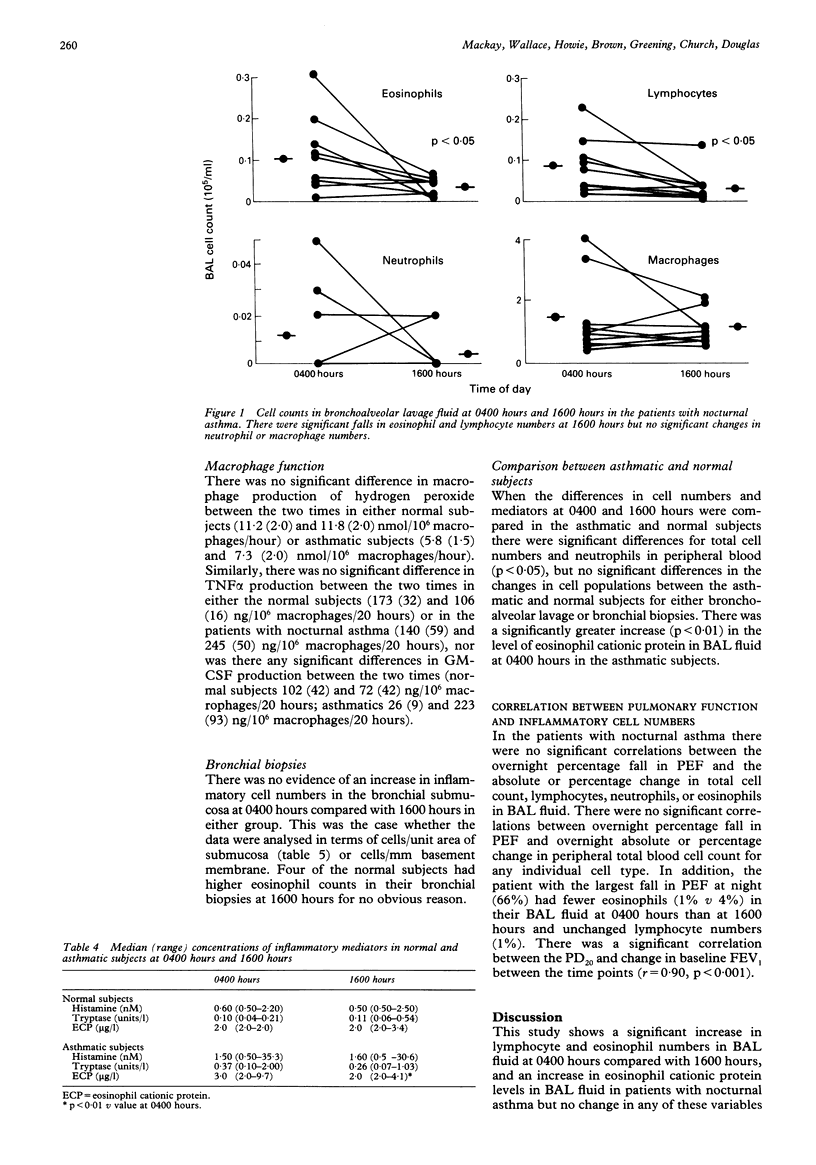
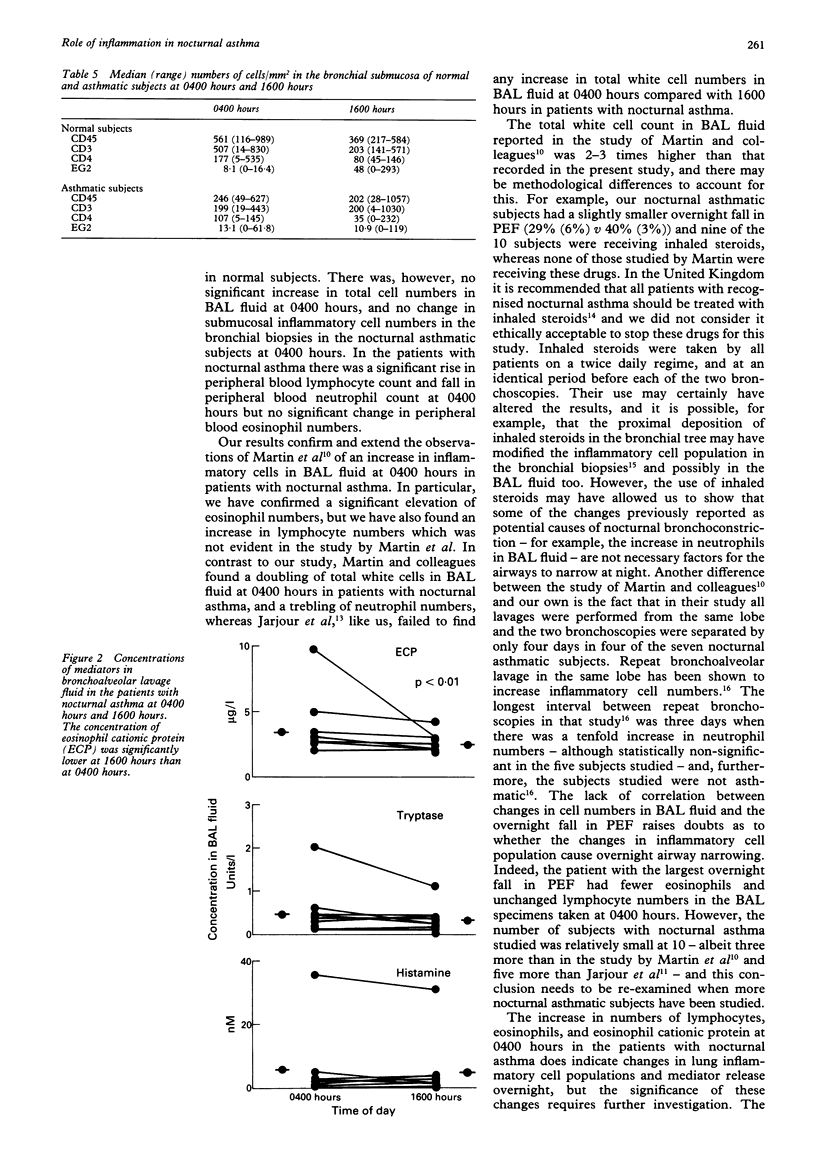
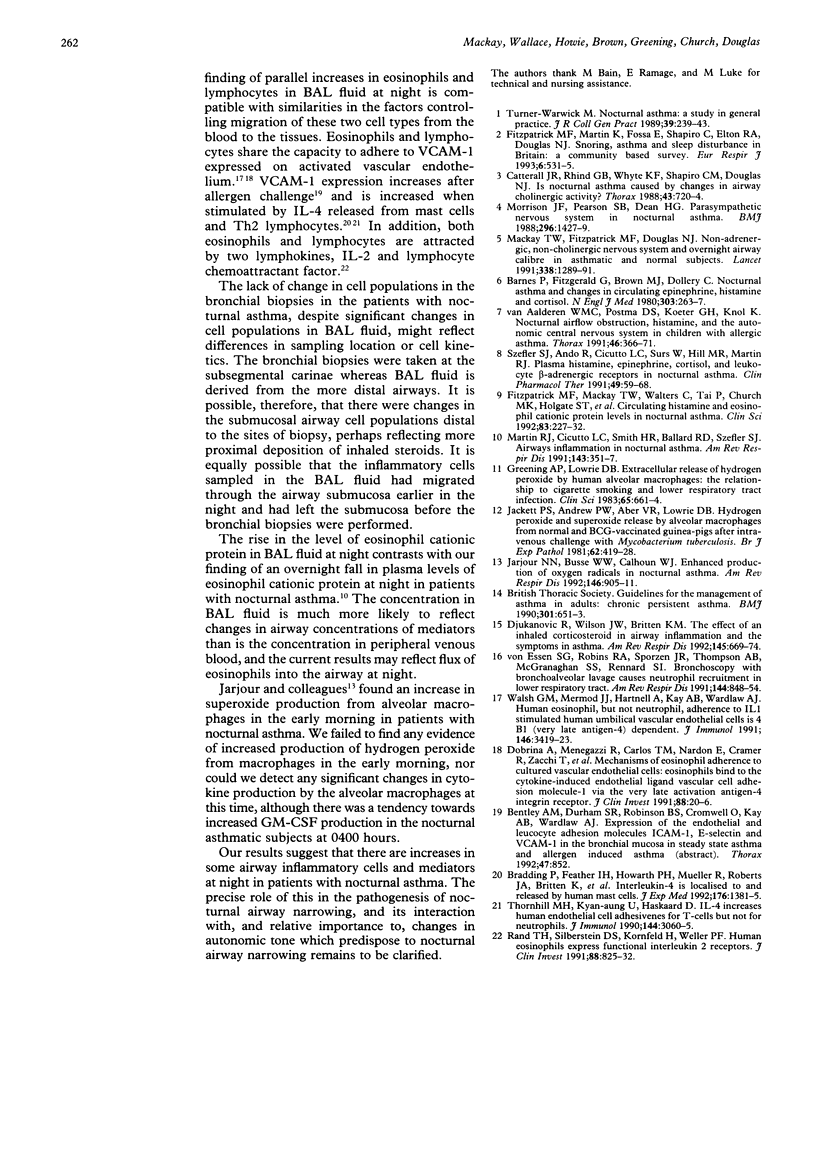
Selected References
These references are in PubMed. This may not be the complete list of references from this article.
- Barnes P., FitzGerald G., Brown M., Dollery C. Nocturnal asthma and changes in circulating epinephrine, histamine, and cortisol. N Engl J Med. 1980 Jul 31;303(5):263–267. doi: 10.1056/NEJM198007313030506. [DOI] [PubMed] [Google Scholar]
- Barnes P., FitzGerald G., Brown M., Dollery C. Nocturnal asthma and changes in circulating epinephrine, histamine, and cortisol. N Engl J Med. 1980 Jul 31;303(5):263–267. doi: 10.1056/NEJM198007313030506. [DOI] [PubMed] [Google Scholar]
- Bradding P., Feather I. H., Howarth P. H., Mueller R., Roberts J. A., Britten K., Bews J. P., Hunt T. C., Okayama Y., Heusser C. H. Interleukin 4 is localized to and released by human mast cells. J Exp Med. 1992 Nov 1;176(5):1381–1386. doi: 10.1084/jem.176.5.1381. [DOI] [PMC free article] [PubMed] [Google Scholar]
- Catterall J. R., Rhind G. B., Whyte K. F., Shapiro C. M., Douglas N. J. Is nocturnal asthma caused by changes in airway cholinergic activity? Thorax. 1988 Sep;43(9):720–724. doi: 10.1136/thx.43.9.720. [DOI] [PMC free article] [PubMed] [Google Scholar]
- Djukanović R., Wilson J. W., Britten K. M., Wilson S. J., Walls A. F., Roche W. R., Howarth P. H., Holgate S. T. Effect of an inhaled corticosteroid on airway inflammation and symptoms in asthma. Am Rev Respir Dis. 1992 Mar;145(3):669–674. doi: 10.1164/ajrccm/145.3.669. [DOI] [PubMed] [Google Scholar]
- Dobrina A., Menegazzi R., Carlos T. M., Nardon E., Cramer R., Zacchi T., Harlan J. M., Patriarca P. Mechanisms of eosinophil adherence to cultured vascular endothelial cells. Eosinophils bind to the cytokine-induced ligand vascular cell adhesion molecule-1 via the very late activation antigen-4 integrin receptor. J Clin Invest. 1991 Jul;88(1):20–26. doi: 10.1172/JCI115278. [DOI] [PMC free article] [PubMed] [Google Scholar]
- Fitzpatrick M. F., Mackay T., Walters C., Tai P. C., Church M. K., Holgate S. T., Douglas N. J. Circulating histamine and eosinophil cationic protein levels in nocturnal asthma. Clin Sci (Lond) 1992 Aug;83(2):227–232. doi: 10.1042/cs0830227. [DOI] [PubMed] [Google Scholar]
- Fitzpatrick M. F., Martin K., Fossey E., Shapiro C. M., Elton R. A., Douglas N. J. Snoring, asthma and sleep disturbance in Britain: a community-based survey. Eur Respir J. 1993 Apr;6(4):531–535. [PubMed] [Google Scholar]
- Greening A. P., Lowrie D. B. Extracellular release of hydrogen peroxide by human alveolar macrophages: the relationship to cigarette smoking and lower respiratory tract infections. Clin Sci (Lond) 1983 Dec;65(6):661–664. doi: 10.1042/cs0650661. [DOI] [PubMed] [Google Scholar]
- Jackett P. S., Andrew P. W., Aber V. R., Lowrie D. B. Hydrogen peroxide and superoxide release by alveolar macrophages from normal and BCG-vaccinated guinea-pigs after intravenous challenge with Mycobacterium tuberculosis. Br J Exp Pathol. 1981 Aug;62(4):419–428. [PMC free article] [PubMed] [Google Scholar]
- Jarjour N. N., Busse W. W., Calhoun W. J. Enhanced production of oxygen radicals in nocturnal asthma. Am Rev Respir Dis. 1992 Oct;146(4):905–911. doi: 10.1164/ajrccm/146.4.905. [DOI] [PubMed] [Google Scholar]
- Martin R. J., Cicutto L. C., Smith H. R., Ballard R. D., Szefler S. J. Airways inflammation in nocturnal asthma. Am Rev Respir Dis. 1991 Feb;143(2):351–357. doi: 10.1164/ajrccm/143.2.351. [DOI] [PubMed] [Google Scholar]
- Martin R. J., Cicutto L. C., Smith H. R., Ballard R. D., Szefler S. J. Airways inflammation in nocturnal asthma. Am Rev Respir Dis. 1991 Feb;143(2):351–357. doi: 10.1164/ajrccm/143.2.351. [DOI] [PubMed] [Google Scholar]
- Morrison J. F., Pearson S. B., Dean H. G. Parasympathetic nervous system in nocturnal asthma. Br Med J (Clin Res Ed) 1988 May 21;296(6634):1427–1429. doi: 10.1136/bmj.296.6634.1427. [DOI] [PMC free article] [PubMed] [Google Scholar]
- Rand T. H., Silberstein D. S., Kornfeld H., Weller P. F. Human eosinophils express functional interleukin 2 receptors. J Clin Invest. 1991 Sep;88(3):825–832. doi: 10.1172/JCI115383. [DOI] [PMC free article] [PubMed] [Google Scholar]
- Szefler S. J., Ando R., Cicutto L. C., Surs W., Hill M. R., Martin R. J. Plasma histamine, epinephrine, cortisol, and leukocyte beta-adrenergic receptors in nocturnal asthma. Clin Pharmacol Ther. 1991 Jan;49(1):59–68. doi: 10.1038/clpt.1991.11. [DOI] [PubMed] [Google Scholar]
- Thornhill M. H., Kyan-Aung U., Haskard D. O. IL-4 increases human endothelial cell adhesiveness for T cells but not for neutrophils. J Immunol. 1990 Apr 15;144(8):3060–3065. [PubMed] [Google Scholar]
- Turner-Warwick M. Nocturnal asthma: a study in general practice. J R Coll Gen Pract. 1989 Jun;39(323):239–243. [PMC free article] [PubMed] [Google Scholar]
- Von Essen S. G., Robbins R. A., Spurzem J. R., Thompson A. B., McGranaghan S. S., Rennard S. I. Bronchoscopy with bronchoalveolar lavage causes neutrophil recruitment to the lower respiratory tract. Am Rev Respir Dis. 1991 Oct;144(4):848–854. doi: 10.1164/ajrccm/144.4.848. [DOI] [PubMed] [Google Scholar]
- Walsh G. M., Mermod J. J., Hartnell A., Kay A. B., Wardlaw A. J. Human eosinophil, but not neutrophil, adherence to IL-1-stimulated human umbilical vascular endothelial cells is alpha 4 beta 1 (very late antigen-4) dependent. J Immunol. 1991 May 15;146(10):3419–3423. [PubMed] [Google Scholar]
- van Aalderen W. M., Postma D. S., Koëter G. H., Knol K. Nocturnal airflow obstruction, histamine, and the autonomic central nervous system in children with allergic asthma. Thorax. 1991 May;46(5):366–371. doi: 10.1136/thx.46.5.366. [DOI] [PMC free article] [PubMed] [Google Scholar]


